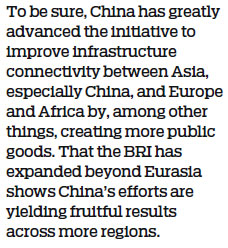Belt and Road harnessing mutual benefits
With Beijing set to host the second Belt and Road Forum for International Cooperation from Thursday to Saturday, it's time to assess the achievements China has made in promoting the Belt and Road Initiative since it hosted the inaugural forum in 2017. To be sure, China has greatly advanced the initiative to improve infrastructure connectivity between Asia, especially China, and Europe and Africa by, among other things, creating more public goods. That the BRI has expanded beyond Eurasia shows China's efforts are yielding fruitful results across more regions.
At the upcoming Belt and Road forum, the participants will discuss how to strengthen the BRI. China has proposed to strengthen the BRI through consultation, co-construction and sharing. And China's efforts to share its economic development ideas and expertise to bring the countries closer through better infrastructure connectivity have drawn the support of almost half of the countries in the world.

While the idea of promoting infrastructure connectivity is welcome, it requires huge amounts of resources to do so. To build a modern airport or a high-speed railway, we need large amounts of funds, which could be sourced from the World Bank or the Asian Development Bank. But since China has helped establish the Asian Infrastructure Investment Bank specifically for this purpose, it is easier to seek the required funds from it to build such infrastructure facilities.















